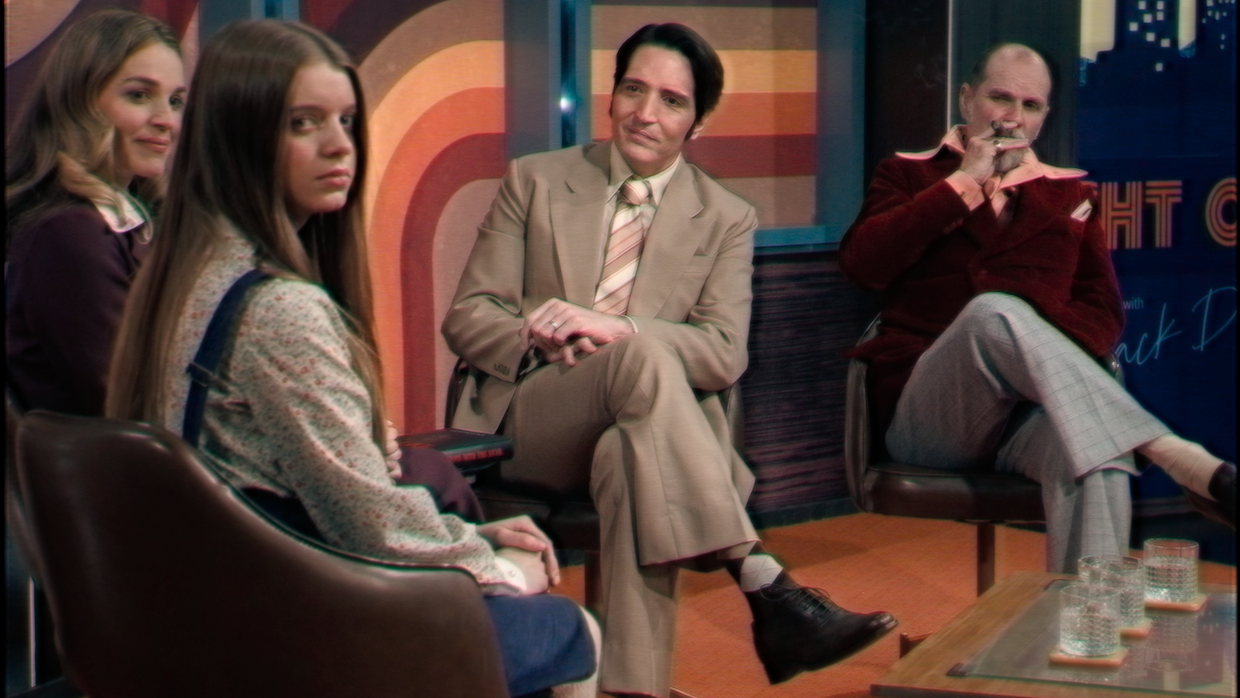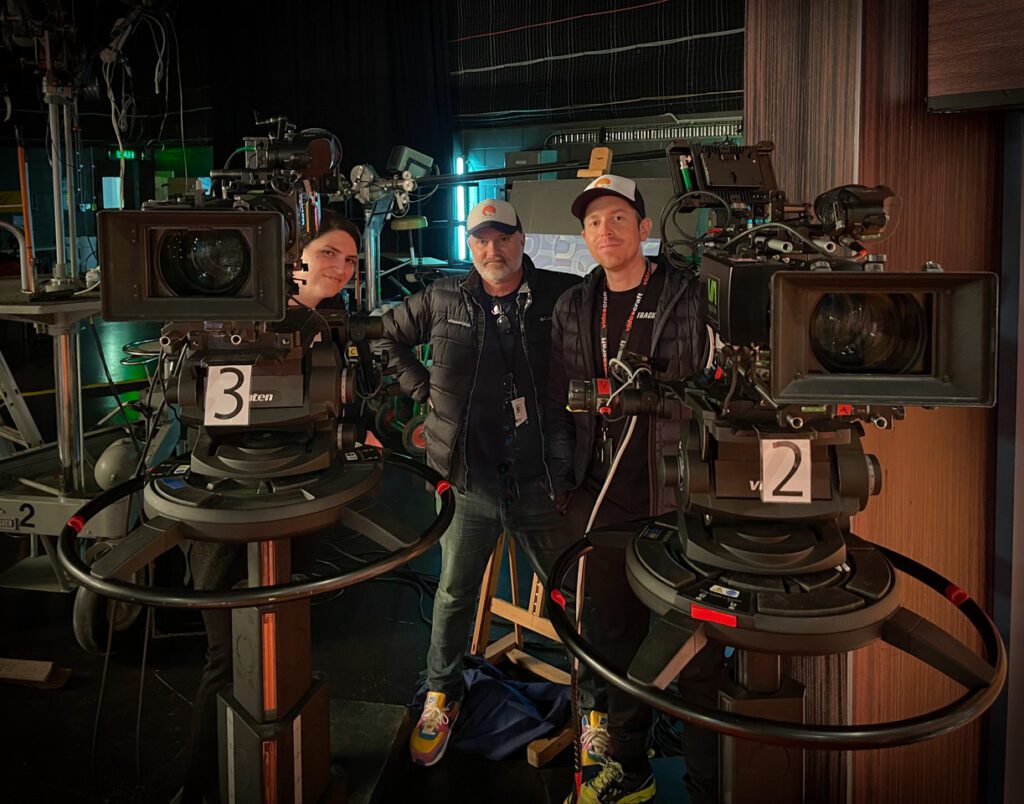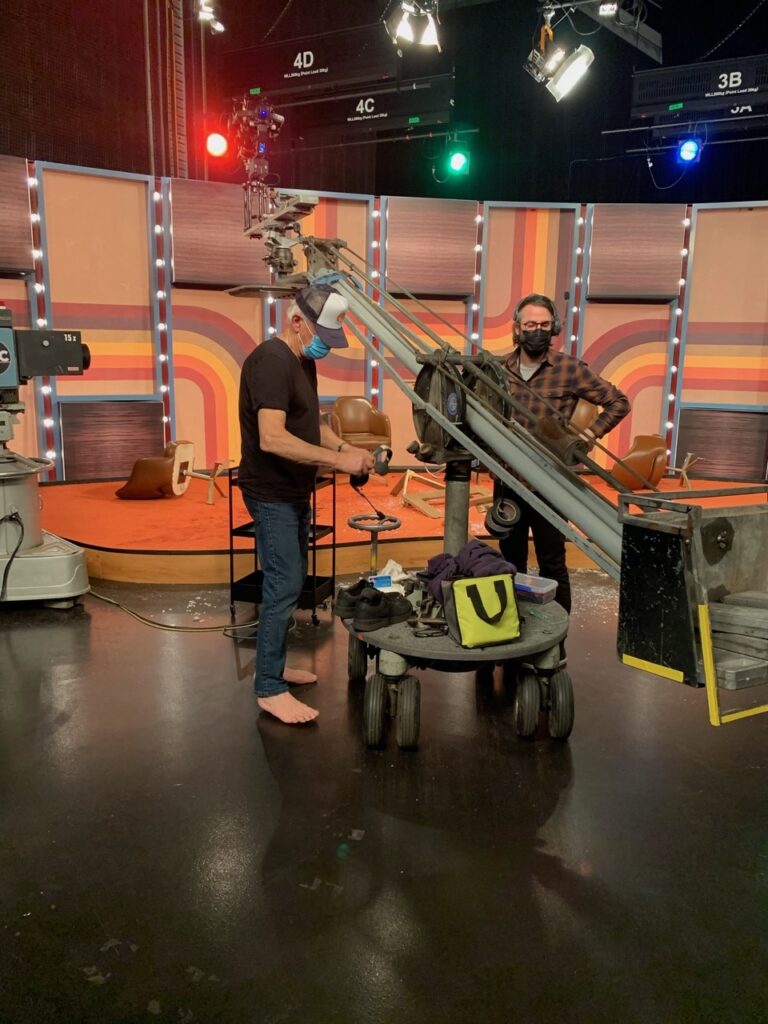 Laura Gordon, Ingrid Torelli, David Dastmalchian, and Ian Bliss in Late Night with the Devil
Laura Gordon, Ingrid Torelli, David Dastmalchian, and Ian Bliss in Late Night with the DevilI typically have two problems with found footage horror movies. First, it’s often hard to believe the characters wouldn’t simply drop their cameras once the body count begins. Just as the haunted house movie must present a sufficiently logical reason for the inhabitants to remain once the voices start whispering “get out,” the found footage horror movie must posit an acceptable rationale for why the cameras keep rolling. Second, the subgenre’s veneer of reality often means some of filmmaking’s most effective tools—score, editing, composition—are sacrificed on the altar of verisimilitude.
The premise of Late Night with the Devil alleviates both of those objections. Set on Halloween night 1977, the movie purports to be the master tapes of a ratings-challenged talk show that brings on a possessed teenaged girl during Sweeps Week.
With Late Night with the Devil currently in theaters ahead of an April 19th streaming premiere on Shudder, Australian cinematographer Matthew Temple spoke to Filmmaker about creating the movie’s seamless 1970s aesthetic during a 20-day shoot in Melbourne.
Filmmaker: Was there a specific talk show from the 1970s that you were emulating?
Temple: [Directors] Colin and Cameron Cairnes shared a lot of YouTube videos with me of different shows in America, but also the Australian versions of those shows, particularly Don Lane. So, I was absorbing all that information and trying to piece together what it was about those shows that made them feel like those shows.
Filmmaker: Was there much difference stylistically in the lighting or camera angles between the shows?
Temple: It was a pretty standard format. There was one show—it may have been the Don Lane show, I can’t remember—that had a bit of a roving handheld camera as well, but we didn’t really want to go down that road because [during the broadcast’s commercial breaks] our black-and-white behind the scenes documentary footage was already going to be handheld. We didn’t want to muddy the waters. So, all of our studio stuff was shot on pedestals or a crane, so that the audience would really feel a difference when we went behind the scenes.
Filmmaker: On the Melbourne soundstage where you shot, were you creating the studio set from scratch or did that facility have an existing TV studio that you dressed and reconfigured to fit your needs?
Temple: One of the sound stages at Docklands in Melbourne is set up for TV production. So, it had some of the structure there, but, at the end of the day, we ended up importing everything we needed. The set was a complete build by [production designer] Otello Stolfo, including the audience seating. There was no existing lighting in the studio—we had to put all that in—but what they did have was an overhead grid to rig lights from. It was really just a bare studio with battens, but having those was a real winner because we were able to rig all the lights easily and put them where they should be. The lighting design I came up with was based on being able to use that infrastructure.
Filmmaker: The directors have said they were tempted by the possibility of shooting this on period cameras. How seriously was that considered?
Temple: We never really seriously looked into it after I was there, but I think sourcing cameras like that could have been quite tricky. And, of course, having to have a 4K deliverable put the kibosh on using old studio cameras.
Filmmaker: What did you end up shooting on?
Temple: I had to deliver in 4K, and I wanted to do that with a Super 35 sensor size. Shooting 6K or 8K with a large sensor would have played directly against what I was trying to achieve.

Filmmaker: Large format definitely would’ve had a different field of view and a different vibe than what you were trying to recreate.
Temple: Exactly. We’re trying to emulate 2/3” tube cameras. Large format would’ve pushed in the wrong direction. I was very keen to avoid that. We shot in 4K [mode] on the Sony Venice, and we had big Fujinon zooms on the cameras. We set the cameras up just like a studio camera for all three of the operators, myself included. We pulled our own focus and did our own zooms. We were going for authenticity. We could have employed three focus pullers and three dolly grips and that would have had a particular look, but for the authenticity of the film I believed that we had to be operating those cameras ourselves—focusing, zooming and moving those cameras on pedestals ourselves—or the audience would have felt something was amiss.
Filmmaker: You started in the business as an operator. When was the last time you were controlling your own zooms and pulling your own focus like that?
Temple: Around 37 years ago. [laughs] I was a studio camera operator back then, but I hadn’t touched a camera set-up like that since. It’s amazing how it comes back to you, though.
Filmmaker: Were those Fujinon zooms newer or older?
Temple: Newer. I did look into older lenses, but finding three matching period lenses would have been difficult. For the behind the scenes documentary stuff, I was also looking at whether we could find two old zooms. At the end of the day, though, you need to be able to deliver everything on time and in good condition, then the backend takes over and the VFX brings that texture in. So, we arrived back at using modern lenses and cameras. I was reassured by the grader and VFX team that all of that [retro] look would be in there at the end of the day. So, I was able to let some of that stuff go.
Filmmaker: It’s funny that you talked about the 4K mandate for the deliverable when the whole idea of the film is that it looks like a 1970s era show in standard definition. Did you do anything in camera—like filtration—to take away the crispness or was the idea, like you just said, to capture everything as cleanly as possible and then use the post process to degrade the footage?
Temple: In my normal DOP life, I’m quite fond of creating looks in camera and getting that on the negative. On this show, it became clear that it was better to deliver images that were clean and, for want of a better word, safe, then have them treated later. So, on set, my obsession was more about making the camera moves feel right and for the lighting cues and camera operation to feel authentic. I actually created a camera operator’s guide. When I was watching all the videos of 1970s shows, the camera operators had particular compositional sensibilities I was really keen to imitate. One of the key things was very central framing all the time. Looking room didn’t exist. If you did a closeup of someone, you kind of framed their head like a balloon [with the entire top and bottom in the shot’. That was my obsession at the point of shooting—getting the lighting right, the operating right, and then the VFX and the grading would do the rest of the heavy lifting.
Filmmaker: You had studio operating experience from back in the day. What about your other two cam ops?
Temple: I was definitely the rusty one. I employed two really experienced studio camera operators, one of whom, Alex Dupen, was purely a studio camera operator, and the other, Rayner Cook, was a part time studio camera operator who also worked in drama for many years as a focus puller and then as a camera operator. My guidance to them was, “If I come up to you after a shot and say, ‘Congratulations, that shot was terrible,’ then [you know you’re] on the right track,” because they’d composed the shot in a properly awkward 4:3, 1970s television kind of way. That was the joke on set. “That shot was terrible” was a compliment.
Another thing I studied in preproduction was how a three-camera studio shoot was covered. I literally watched talk show interviews, hit pause and went, “Okay, that’s camera one and it’s here.” Then I’d watch again and pause and go, “Okay, camera two is holding the wide shot of the stage.” I’d play again and pause: “Camera three is doing a single back that way.” One of my rules was to not put a camera where it couldn’t reasonably go in a given time. If an operator couldn’t physically get the camera from one spot to another and reframe it in [the amount of real time that would’ve elapsed], then that shot was illegal.
Filmmaker: I imagine those 1970s talk shows shot at a deeper stop than you would normally shoot at.
Temple: I didn’t know exactly what stop they were shooting at then, but I could look at the footage and get a feeling for the depth of field they were working with. So, instead of shooting wide open, which you might try to do a lot on a drama, I found a stop that gave us that feel of the depth of field of a 1970s show, which was around a T4.
Filmmaker: Did you create a LUT for the shoot to give you some approximation on set of what the final period look might be?
Temple: We had two LUTs. The studio shoot LUT was a desaturation of all those intense colors and a bit of a softening of the contrast, but nothing radical. It just sort of pushed us in the right direction. Then the LUT we had for the behind the scenes stuff, interestingly, was based on a color film look that had a lot more color depth and more contrast, because that was also initially planned to be in color. But when Colin and Cameron started to edit the show, they felt that the difference between the studio stuff and behind the scenes stuff wasn’t immediately apparent to the audience. So, in postproduction, the behind the scenes footage was changed to black and white and that was based on a Fuji black and white stock that had some grain. To be perfectly honest, the black and white was a surprise to me at first, but it was totally the right choice.
Filmmaker: I was going to ask you about grain. Adding grain is one of the shortcuts that contemporary filmmakers often seem to use when recreating the look of 1970s movies. But you’re trying to emulate a very specific 1970s broadcast television look here, so you couldn’t really use that “slather it in grain” shortcut for most of Late Night with the Devil.
Temple: I was really blessed to have a fantastic color grader, Nicholas Hower, from Post Lab IO. He was, from the get-go, absolutely obsessed with what makes something have that video look. It was Nicholas’ deep dive that really lifted the pictures. He worked with things like chromatic aberration, lens distortion, clamping down the color range and misaligned RGB channels, because the studio cameras were three tube cameras with a prism, and I know from my own experience back in the day that those go out of alignment. He worked on layers and layers of these ideas. He just did a fantastic job and we’re all really grateful for his obsession.
Filmmaker: You didn’t go down the route of vintage cameras or lenses, but you did dust off some older lighting units.
Temple: I worked with my regular gaffer, Matt Begg, on this job and we have a regular drama package that we shoot with on all the stuff we do together. But for Late Night with the Devil, we dug through all these units that the lighting rental house had on their shelves. They were full of old tungsten lights where you literally had to blow the dust off and plug them in to see if they still worked. Finding these old tungsten lights was just like finding gold: “Wow! Look at these zip lights! They’re going to be beautiful soft lights. These ground rows are going to be great for the background.” I was really keen to use those older lights because, for one, I wanted the quality of the light to feel right, but the second consideration was that I knew we’d be getting those lights in shot at various points and wanted them to look accurate.
Filmmaker: I can’t remember the names of all those old units anymore —Inkies and Tweenies and all those things—but is that the type of stuff you were using? Those old purple-ish Mole-Richardson units?
Temple: Yeah, exactly right. Some of them were those beautiful old Mole-Richardson lights. Our zip lights were that purple color. They weren’t all exactly the lights I remember in the studio coming up, but they were certainly the right era.
Filmmaker: Were you putting gels on those lights?
Temple: I was keen to keep everything pretty neutral in terms of light color. We used diffusion on some lights, but I didn’t color many of them. I did gel some of the par cans that were in shot just to give them a little bit of something, which you see reflected off the floor in some of the wider shots. For behind the stage, I didn’t want that to just go to black, so I rigged vertical old school fluorescent lights and gelled them with a particular blue color so they really rung out against the studio walls.
Filmmaker: The directors said in an interview that you had some sort of Italian dolly from the 1970s.
Temple: We had a period-correct crane. My regular grip, Dean Garro, and I went to his warehouse where he’s got all sorts of gear. I said, “We need a small crane for the job. I don’t want some huge thing that just wouldn’t feel right, and we don’t have the manpower for it anyway. So, what have you got?” He pointed into the corner of his warehouse and there was this fantastic 1970s crane with its original paint. Dean said, “We’ll just give it a bit of a grease and dust it off. I think that’ll be perfect.” He was absolutely right. It was just the right size and had just the right amount of instability to give the camera a little bit of a wiggle as it’s going in on a crane shot, just like I’d observed in the YouTube videos [of 1970s-era talk shows].

Filmmaker: Did you do the crane moves on dolly track or were you just rolling it on the studio floor directly?
Temple: Our legendary key grip, Tony Hall, was pushing it on wheels on the studio floor. He actually slipped his shoes off to do it because there was so much talcum powder around to give him a smooth surface that he couldn’t get any grip with his shoes on.
Filmmaker: I don’t want to give away any of the specific practical effects gags, but let’s just talk in general about your experience lighting and designing coverage for some of those set pieces.
Temple: As much as possible, we ran scenes all the way through and pulled the cameras into new positions and changed lighting cues [as if it were a live show]. But when it comes to doing a physical effect, everything has to stop, and we would move the cameras to the right spot to sell the effect in the best way possible. As far as lighting goes, of course we tweaked the lighting from set-up to set-up, but I tried to essentially keep everything within the reality of the scene, because we wanted the show to feel like it was all happening in that moment. If we had shifted to an extreme camera angle or lighting set-up just for an effects shot, it would take you out of that moment.
"congratulations" - Google News
April 12, 2024 at 02:06AM
https://ift.tt/OxRUJi0
“Congratulations, That Shot was Terrible”: DP Matthew Temple on Late Night with the Devil - Filmmaker Magazine
"congratulations" - Google News
https://ift.tt/RcbmTSt
Shoes Man Tutorial
Pos News Update
Meme Update
Korean Entertainment News
Japan News Update
Bagikan Berita Ini














0 Response to "“Congratulations, That Shot was Terrible”: DP Matthew Temple on Late Night with the Devil - Filmmaker Magazine"
Posting Komentar